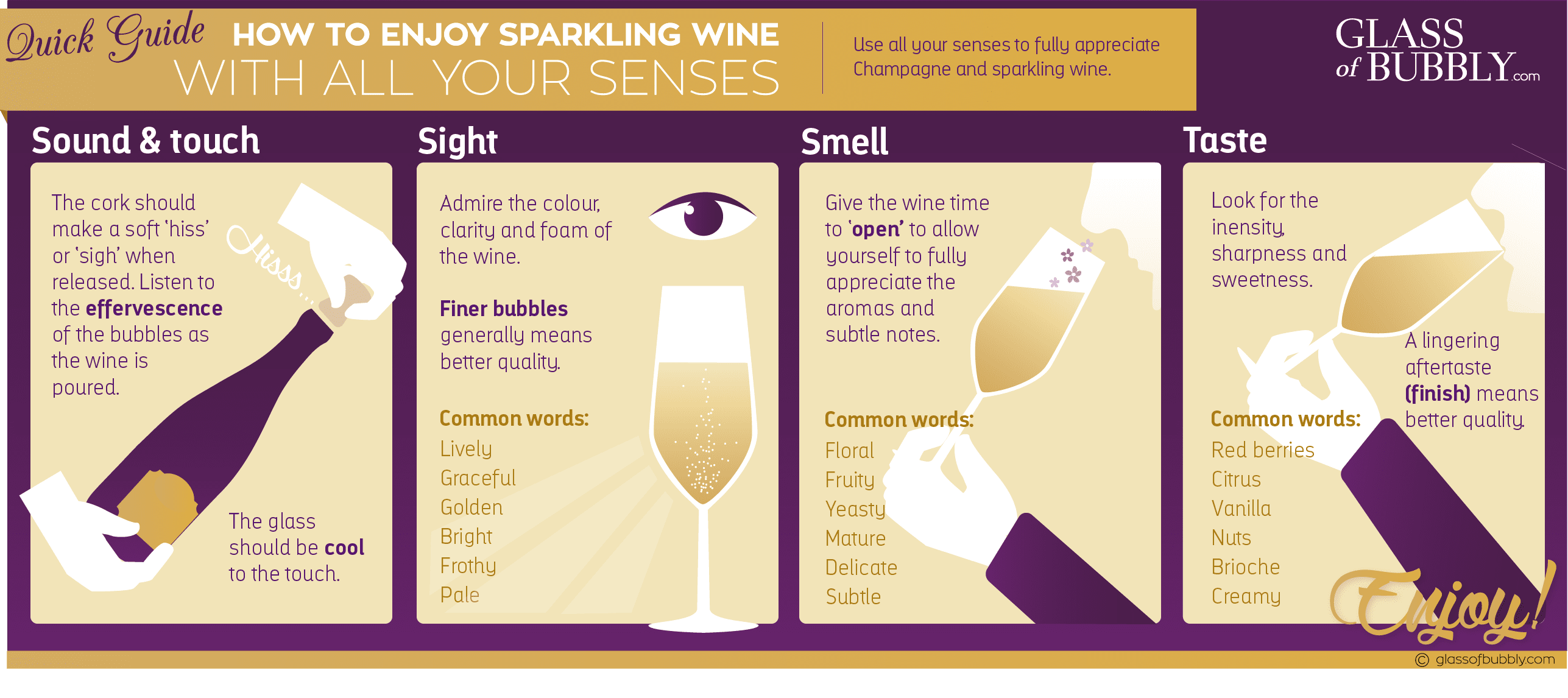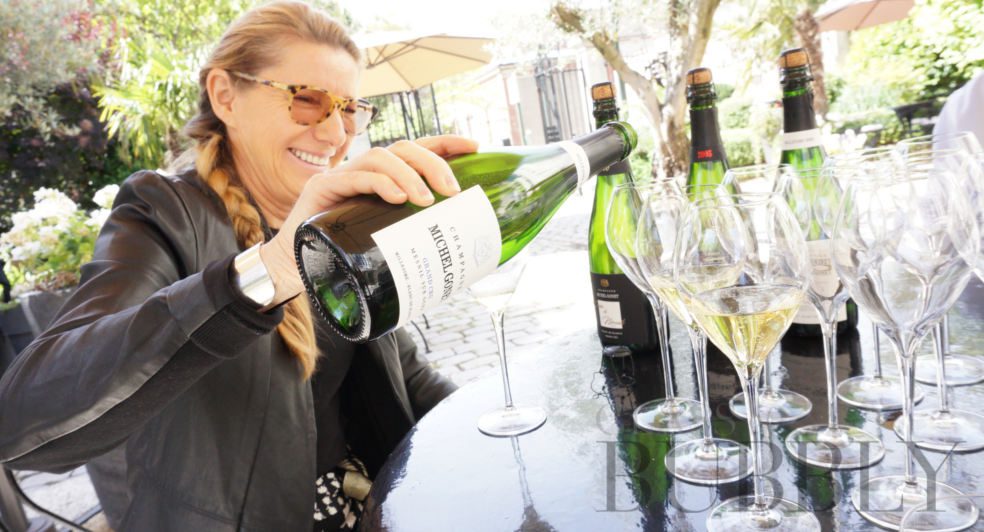Characteristic Tastes & Flavours of Champagne
6th April 2023

After many years of tasting and reviewing Champagne with a quite significant list of wineries and labels that I have enjoyed, I think it’s a good idea to break down, in to an easy to understand format, the tastes and the flavours to look out for.
For those of us wanting to take time over our glass of Champagne to study the performance and maybe even to record our own tasting notes and / or scores, then we need to adopt a process that we clearly understand and importantly, works best for us. Many senior wine reviewers and judges embrace similar styles when it comes to evaluating the wines in the glass, though each will have their own unique method. Even scoring wines can be varied with some preferring to use the 20 points system and others scoring out of 100.
As with most aspects within the subject of enjoyment of wine, it is down to personal choice, as what may be my preferred style of wine might not be yours – Who has the right to tell you what glass to pour the wine into or the ideal temperature to serve it at? Guidelines are out there to offer you the best tasting experience, it is down to you if they work for your palate!
Despite wine being a personal taste experience (we all have very different palates) there are many guidelines and information sources offered to help us on our wine journey of which many, in my honest opinion, are well worth investigating. From senior wine professional comments to wine educational websites / books that explain in the most engaging way, with added imagery / infographics / videos, exactly what is in your glass and the perfect way to serve it.
When we have the chance to spend time on our glass of Champagne we can embrace three main areas:
- Visual
- Aroma
- Taste
Each of these above, especially the aroma and flavour, we can spend plenty of time embracing the complexity / layers on offer. For many, and rightly so, the main experience is the all important taste where we get to fully explore the characters of the wine, the work of the wine maker, the terroir and more.
Many of the taste characters from Champagne we will have noted prior in the aromas as both sensations are closely linked. Once in the mouth, it is important we take our time to allow the wine to explore different areas as our taste buds are located in different locations. We are said to have between 2,000 to 8,000 taste buds on our tongue – Taste buds contain the taste receptor cells, which are also known as gustatory cells. The taste receptors are located around the small structures known as papillae found on the upper surface of the tongue, soft palate, upper esophagus, the cheek, and epiglottis. (source wikipedia)

How to enjoy a glass of Champagne
Initially we can look at taste characters of which there are four main areas to run through:
Sweet: The natural sugars from the grape or any added sugars will be received mostly by the front of the tongue, lips and gum area. The reaction (I am sure you can feel it already) causes saliva secretion from the sub-lingual glands. Depending on the sugar levels, the wine will offer us descriptive words such as heavier, smoother, oily, rounded.
Bitter: Here we will expect a dry taste sensation closing down the pores in the mouth and giving an almost tightening of the palate experience. Usually created by the tannins and experienced towards the back of the tongue, it is the least desired taste that Champagne should offer.
Acidic: From either the grapes themselves or the production (fermentation) process, good acidity from Champagnes is highly desired. The sharp, refreshing and edging towards sour taste it offers comes via the side of and underneath the tongue area. Mouth-watering effect from acidity causes abundant liquid salivation.
Saline (Salt): Another mouth-watering experience comes from the salty levels in Champagne, originating from salts of mineral and organic acids. Side edges of the tongue will get the most taste experience along with production of fleeting salivation.
Thrown in amongst the taste characters we will be looking for balance of taste characters. Here, importantly, we seek perfect interaction of the taste sensations which are not so much in cancelling each other out such as one gram of sugar against one gram of salt, but more how the wine showcases its synergism. Here we are looking at taste complementing each other, masking and contrast qualities.
Now on to the character flavours of Champagne which we can break down in to five main areas:
Freshness: Young and bold in character, for recent releases this is an all important feature Champagne lovers are seeking. As the wine ages and matures, the acidic characters fade and we see a more complicated, rounded and smoother taste.
Finesse: Clean and clear taste, balance of flavour will help to build the finesse of the Champagne. Purer in style and likely to be made from the first press.
Fruitiness: From the different variety of grapes used to make Champagne (primarily Chardonnay, Pinot Noir and Meunier) we will see fruit flavour levels. From white / yellow fruits thanks to Chardonnay to red berry via Pinot Noir, fruitiness is a special feature of Champagne though usually not all over powering such as what is experienced from Superior Prosecco sparkling wines. As the Champagne matures, the freshness of the fruits will decrease into riper / dried fruits or fade altogether.
Body: Usually in relation to the heaviness character (though mostly used to describe still / sparkling red wines), within Champagne the alcohol levels are still quite high in 12 to 12.5% so a body is still experienced, though more towards a lighter style. As Champagne matures the body will increase as will the richness.
Persistence: Once the Champagne has been consumed we are then exploring the length the flavours remain on the palate. Was it just an initial taste explosion such as per the fireworks delivered by the Meunier grape, or have we a long fruity / floral / yeasty expression with Chardonnay?

For the best Champagne Tasting experience – Embrace it with all your senses!
Of course, if we mention favours of Champagne many will also expect a host of descriptions such as apple, peach, citrus, floral, toasty, nutty and more and this list is quite extensive and varied as we travel from winery to winery, terroir to terroir. These additional descriptive words complement the above taste and flavour characters and will usually be used when taking tasting notes and especially when explaining to the end consumer what to expect from the Champagne.
When tasting Champagne we can embrace four of our senses:
Sight (ie; how tiny are those bubbles, what shade of gold is the wine)
Sound (ie; let’s listen to those bubbles)
Smell (ie; take in that bouquet)
Taste (ie; enjoy those flavours, how long do the flavours linger)
and we could indeed add Touch too if we want to make sure the bottle of Champagne is well chilled!
*References / Research taken from ‘Champagne – Pleasure Shared’ by Éric Glatre. 2000 Hoebeke.
![]()
Christopher Walkey
Co-founder of Glass of Bubbly. Journalist and author focused on Champagne & Sparkling Wines and pairing them with foods.
